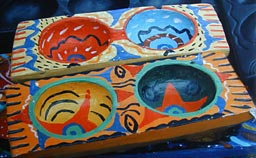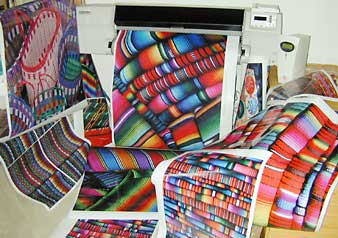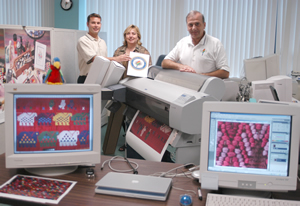Epson 1520, Epson 3000 and Epson 5000 wide format inkjet printers.
The Epson 1520, Epson 3000, and Epson 5000 turn themselves into a color proofer for prepress companies if combined with a proofing RIP such as ProofMaster, CGS ORIS, or comparable RIP for proofing. Epson is famous for making inkjet printers at an economy price. You don't generally need long lasting output for a proof, so most prepress places use dye inks.
Most good inkjet printers work better if harnessed to a RIP. To learn what a RIP is, go to the index (links at bottom of every page). In the index go to the pertinent pages of RIPs. There is different and additional information on RIPs on all the other printer sites, so be sure to visit those other sites as well. Selecting the right RIP is as crucial as figuring out which printer is the most appropriate your needs and pocketbook.

|

|
| Look
at this color, this is what the ads for Epson printers
promise. Beautiful, rich, deep, colorful colors. Yes,
you get this quality with every Epson printer, but colors
made fade. You can avoid the fading by using aftermarket
inks such as Lyson, Staedtler, etc.
Yet these prints are from a Hewlett-Packard DesignJet 2800CP. These colors will hold their beauty even with dye based inks. This is the advantage of the 4-ink system; it's the weaker extra two inks of a six ink system which may fade first. 11x17 prints enlarged from 35mm color slides with a Scitex EverSmart Supreme flatbed scanner; photographs by Nicholas Hellmuth of indigenous Mayan handicrafts, Chichicastenango and Panajachel, Guatemala, FLAAR Photo Archive, scanned and printed at the Digital Imaging Technology Center, Essen, Germany. |
|
Epson has successfully marketed an economical printer which puts color printing on the desktop at a price people can afford. The problem is when a printer made for home use/occasional office use is used for professional or commercial use. Then it may be the inappropriate printer.
"I did my own test with printing on Epson photo paper and it has now been 6 months and the half I have in sunlight is streaked and undeliniated. So much for personal printers.
It seems to me that they are all misleading the public with implied durability when in fact the results are only good for weeks, not months or years. I use mine now for making greeting cards of my artwork. You can't expect years of use from a greeting card.
Thank you for your web site. It is the only place I have been able to find such information."
Summary: Yes, we have met people that tweak outstanding images out of an Epson 3000. If you have an appropriate RIP software, you can get consistent professional images from the Epson 1520, Epson 3000, and Epson 5000 printer (and from the Epson 7000 and 9000 as well). If you use aftermarket third-party inks you escape the expensive inks that fade rapidly.
I am a Mac user, and have just purchased an Epson 1520. The printer seems really temperamental, and I get many "OUT OF PAPER" messages when there is plenty of paper. It also does quite a bit of whizzing and whirring for some reason when there is no printing happening. Unusual?
Within one week we got two e-mails, one from a person who was perfectly content with his Epson 1520 printer, and another who wanted to upgrade to a better printer. The advantage of an Epson printer is that you can use it as an economical way to experience with fine art prints, to experiment with the various inks, and to learn more about digital imaging. We would, however, recommend that you consider the Epson 7000 as your entry level machine, or even an Encad Chroma 24 (albeit a rather rough ink dot pattern). In the long run you will get a more professional output from a printer which is made for serious wide format printing.
 |
FLAAR
images about to be printed on Epson 7600 at Parrot
headquarters
|
Overall we receive more complaints on the Epson 1520 and Epson 3000 than on any other printers (with the possible exception of the complaints on the Epson 1270 and Epson 2000). If you would like to know more about these printers before you buy one, better send us an e-mail.
If
your clients expect an Iris giclee print, then you need a
CreoScitex Iris printer but if your budget won't cover an
Iris, there are many other printers to select from, such as
Epson, Roland, HP, Mimaki, Mutoh, ColorSpan, or other fine
art printers. Enter the world of digital fine art printers
on www.FineArtGicleePrinters.org
Parrot
Digigraphic is a place to get the large format models of
Epson. Parrot Digigraphic is for serious wide format which
means the models 2200, 7600, 9600, and up through to the
new 1440 dpi variable droplet model Stylus Pro 10600. If
you need a printer wider than Epson, Parrot now also sells
the Mutoh Falcon II. Same printheads as the Epson printers
but much wider.
ortunately the Epson 1520, 3000, 5000, 5500 are no longer made. But they linger on eBay. Avoid them. You are much better off with the newer models such as 2200 and 7600.
If
you really want technical details on inkjet media, inks, and/or
inkjet printhead technology, and especially if you wish to
meet the movers and shakers in this industry, be sure to sign
up for the next conference organized by IMI. Their contact
is [email protected].
These seminars are outstanding; the senior review editor of
FLAAR usually attends because he can get so much fresh information
for the readers of the FLAAR Reports in PDF format and the
FLAAR Information Network of web sites.
Most recently updated May 14, 2003.
Previous updates: July 11, 2001.